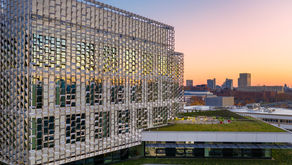The Swedish Way
- isabossav

- Jul 30, 2020
- 3 min read
Updated: Sep 17, 2020
Sweden was our last stop on a winter trip around western and northern Europe. Already worn out by all the traveling and the cold and dark Scandinavian winter, I started to doubt whether adding Sweden to the journey had been a good idea. The country was not very welcoming at first either. Early on in our stay, we got lost several times while trying to navigate Stockholm (the city is built on 14 islands and connected by 57 bridges). Architecturally, the bridges are a beauty, but for tourists like me, they can be a disorienting nightmare.

The basic Swedish I speak is barely enough to have a short, casual conversation and did not help us much when trying to decipher the city signs that, unlike in many other European cities, were not translated into English. We went up a bridge when, out of nowhere, the pedestrian sidewalk ended (there was a sign at the beginning that probably had a warning about it but, not understanding what it said, we just ignored it). As we were making our way back, it started raining hard, a big car passed by and I got splashed from head to toes.
We were still reeling about the bridge incident when we got lost again. From the direction we were coming, we found no way to cross over to the island where our hotel was. Google maps, usually so reliable in the US, kept on insisting that we just walked to our destination, disregarding the bay in front of us.
Despite the early mishaps, the more we explored and learned about the city, the more it grew on us. The short days (Stockholm has about 6 hours of daylight during winter) did not play in our favor and we could not do nearly as much as we wanted, but we thoroughly enjoyed the beautiful buildings and canals, many museums, breathtaking views, and historic districts. I particularly liked Gamla Stan (Stockholm's Old Town) with its colorful buildings and cobbled streets. Something about winter made the district's medieval character and narrow alleys feel cozy and calming.

One night on our way back to the hotel, we stopped by Kaffekoppen in what turned out to be one of the best surprises of the trip. The best word to describe the experience at the café would probably be the Swedish mysig (cozy, pleasant, comfortable, agreeable). We had a wonderful candlelit dinner and the café's glögg is to this day the best mulled wine I have ever had.

Fascinated by the ideas of fika and coziness, I started learning about the Swedish culture, attitudes and traditions, and found the Swedish way to be an interesting, at times wise and at others intriguing, way to live life. Midsommar, fredagsmys and fika are three of the traditions I found the most appealing.
Midsommar (Midsummer)
Sweden's most important tradition, usually celebrated in the countryside. It involves, among other things, wearing a flower wreath, raising a maypole (previously decorated with flowers and wreaths), a lot of dancing (around the pole), and accordion music. The food and drinks traditionally include herring, strawberries, beer and schnapps.

One of the most popular songs during Midsommar is Små Grodorna (The Small Frogs). The song, which apparently is beloved by Swedes of all ages, goes:
"The small frogs, the small frogs, are funny to look at. No tails, no tails, they have no tails. No ears, no ears, they have no ears"
Fredagsmys (Friday "coziness")
Can you be a fan of something you didn't even know existed? Because that is how I felt about Fredagsmys when I first learned about it. For Fredagsmys, Swedes celebrate the end of the workweek by gathering with their family or partner to eat tacos, drink something, and watch TV or a movie cozied up in a sofa with crunchy snacks.
Fika (Coffee Break)
There is no exact translation for fika but it is something like a social coffee break. Swedes describe it as a "concept, a state of mind, an attitude". Fika can happen at any time, with anyone from close friends to acquaintances you are getting to know, and at home, work or a cafe. The crucial thing is to have a cup of coffee with a little something to eat, and beyond that, to make time to stop and socialize. According to Fikaraporten, Swedes take 268 hours' worth of coffee breaks and consume 11.5 kilos of coffee and 11.5 kilos of bakery products per year.
My favorite of the three is probably Fika (although Fredagsmys is a close second and I would love to participate in a Midsommar celebration at some point in my life). Despite avoiding coffee, I love tea and "coffee" breaks, and I agree with the Swedes' belief that when you take the time to pause, have a hot drink and socialize, your refresh your brain and strengthen your relationships.







Comments